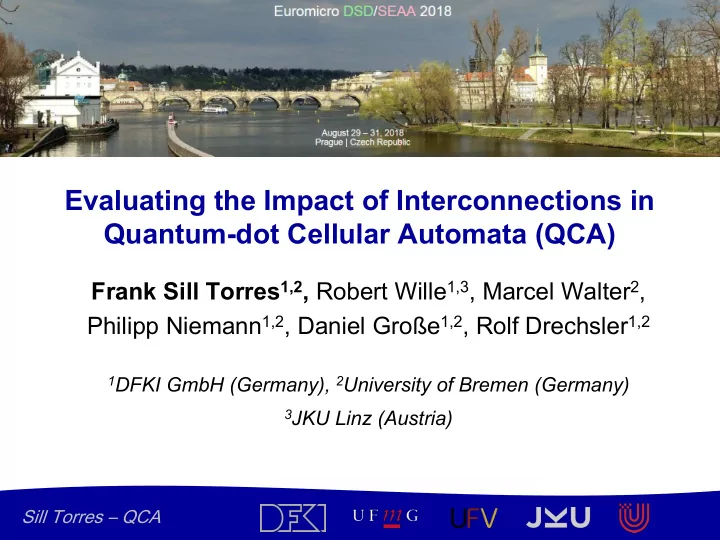

Evaluating the Impact of Interconnections in Quantum-dot Cellular Automata (QCA) Frank Sill Torres 1,2 , Robert Wille 1,3 , Marcel Walter 2 , Philipp Niemann 1,2 , Daniel Große 1,2 , Rolf Drechsler 1,2 1 DFKI GmbH (Germany), 2 University of Bremen (Germany) 3 JKU Linz (Austria) Sill Torres – QCA
Outline Motivation Design Automation Analysis Environment Results Conclusions Sill Torres – QCA 2
Motivation Quantum-dot Cellular Automata (QCA) Promising nanotechnology based on quantum dots Remarkable low energy dissipation Several (experimental) physical realizations based on different concepts (Metal islands, nanomagnets, dangling bonds, …) Nanomagnets Metal islands Dangling bonds Sill Torres – QCA 3
Motivation Interconnections Challenging routing in QCA – QCA is (nearly) planar technology Current state: 1 layer for logic & routing, 1 layer for crossings Outlook: low amount of layers – Data flow must follow clocking constraint (clock 1 → clock 2 → clock 3 → … ) – Only orthogonal routing Simple example: a 2 1 3 Routing overhead a f f 4 3 2 b b Sill Torres – QCA 4 3 4 1
Motivation Interconnections cont’d More complex design 2 4 1 3 1 4 3 2 4 1 s 3 4 2 3 1 3 2 1 4 2 a 4 1 2 3 1 4 3 2 1 4 co b Interconnections with notable impact on Area, Delay, Energy increase Question: What is the actual impact? Sill Torres – QCA 5
Design Automation Comparison CMOS Process QCA Process No Differences Some Differences Transistors and QCA cells and connections its positions Layers of specific MOS layers material Sill Torres – QCA 6
Design Automation Principal Flow 4 1 2 3 2 3 4 1 HDL Description Tile (clock zone) grid a a g2 f s s 4 1 2 3 g3 b f b Netlist 1 2 3 4 Layout Sill Torres – QCA 7
Design Automation Gate Library Routing Elements Simple Gates Complex Gates Wire Inverter NOR Majority Bent wire XOR Sill Torres – QCA OR 8 Fanout
Design Automation Energy Model Components of energy dissipation of QCA: E clk - Energy from clock - E out - Energy to E in - Energy from neighboring cell(s) neighboring cell(s) - E env - Energy to environment Dissipated energy: E env = E clk + E in – E out ( ) ∫ = Γ⋅ λ + Γ η E tanh dt ' env th 2 QCADesigner-E - Physics simulator including determination of energy dissipation of QCA (https://github.com/FSillT/QCADesigner-E) Sill Torres – QCA 9
Design Automation Characterized Gate library Energy Disspation [meV] Area Delay Regl. Mode (25 GHz) Fast mode (100 GHz) [µm²] [tiles] ... 111 000 ... 111 000 Elements Routing Wire 0.01 1 0.09 ... - 0.82 ... - Bent-wire 0.01 1 0.10 ... - 0.84 ... - Fanout 0.01 1 0.12 ... - 1.15 ... - Inverter 0.01 1 0.13 ... - 1.19 ... - Logic Gates Majority 0.01 1 0.15 ... 0.15 1.41 ... 1.41 OR 0.01 1 0.18 ... - 1.30 ... - NOR 0.02 2 0.31 ... - 2.49 ... - ... ... ... ... ... ... ... ... ... Sill Torres – QCA 10
Analysis Environment P&R Algorithm 1. Diagonal arrangement of 3. Diagonal placement of each clocking level o 1 1 2 3 1 2 3 o 2 2 3 4 2 3 4 o 3 3 4 1 3 4 1 2. Levelizing of netlist graph 4. Routing o 2 o 6 o 1 2 1 3 o 2 o 3 2 3 4 o 3 o 1 o 4 3 4 1 L1 L2 L3 Sill Torres – QCA 11
Analysis Environment Flow Synthesis: – Synthesis library (*.lib) for QCA gate library – Synopsys Design Compiler – ABC (AIG, BDD) EFPL Benchmarks Benchmark name Outputs AND nodes Inputs Adder (adder) 256 129 1020 Barrel shifter (barrel) 135 128 3336 Max (max) 512 130 2865 Sine (sin) 24 25 5416 ... … … … Sill Torres – QCA 12
Results Area Area Interconnection Overhead 10000 8000 6000 4000 2000 0 0 1000 2000 3000 4000 5000 6000 AND nodes of initial benchmarks AIG BDD Comm Sill Torres – QCA 13
Results Delay Delay 60 Interconnection Overhead 50 40 30 20 10 0 0 1000 2000 3000 4000 5000 6000 AND nodes of initial benchmarks AIG BDD Comm Sill Torres – QCA 14
Results Energy Dissipation Energy (Regular) 700 Interconnection Overhead 600 500 400 300 200 100 0 0 1000 2000 3000 4000 5000 6000 AND nodes of initial benchmarks AIG BDD Comm Sill Torres – QCA 15
Conclusions QCA is a promising nanotechnology for low energy applications Specific characteristics of QCA design require notable amount of interconnections Here: Evaluation of this impact Results indicate high impact of Interconnections with consequences on area, delay, energy Requirements for future research: – Comprehensive synthesis cost model for interconnections – New synthesis strategies with emphasis on reduction of interconnections – Exploration of new concepts (systolic arrays, logic duplication, …) Sill Torres – QCA 16
Thank you! frasillt@uni-bremen.de Sill Torres – QCA 17
Evaluating the Impact of Interconnections in Quantum-dot Cellular Automata (QCA) Frank Sill Torres 1,2 , Robert Wille 1,3 , Marcel Walter 2 , Philipp Niemann 1,2 , Daniel Große 1,2 , Rolf Drechsler 1,2 1 DFKI GmbH (Germany), 2 University of Bremen (Germany) 3 JKU Linz (Austria) Sill Torres – QCA
Recommend
More recommend